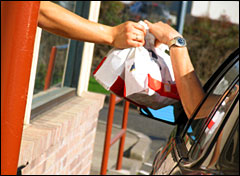As their grocery bills rise, Americans should take comfort: the price they’re paying for industrially produced food in the supermarket is starting to approach that of artisanally produced food at the farmers’ market. And that might make more of them choose healthier, less environmentally destructive diets. At least, that’s the message of an article in Wednesday’s New York Times titled “Some Good News on Food Prices.”

Michael Pollan.
Photo: Ken Light
To make her case, reporter Kim Severson turned to two Berkeley-based icons of the sustainable-food movement, author Michael Pollan and restaurateur Alice Waters. “Higher food prices level the playing field for sustainable food that doesn’t rely on fossil fuels,” Pollan told Severson.
People struggling with their food bills should “make a sacrifice on the cell phone or the third pair of Nike shoes,” Waters advised.
All due respect to Pollan and Waters, but I think they are grossly simplifying matters here. Nationwide, heightened food and gasoline prices, combined with an economy that’s shedding jobs, are putting a hard squeeze on consumers. According to The New York Times, applications for food stamps have surged recently, and the program is projected to reach 28 million Americans over the next several months, the most since its inception in the 1960s.
I have a hard time imagining people who are struggling to put food on the table rambling off to the farmers’ market on Saturday to fill cloth bags with the sort of fresh, local, organic produce so beloved by Pollan and Waters (and me). Indeed, higher food prices are likely to send many time- and cash-strapped people in quite the opposite direction.
Rising costs may end up increasing the allure of large entities with economies of scale, cutthroat buying practices, and experience in transforming low-quality ag inputs into stuff people like to eat. I’m talking about fast-food companies, which can likely absorb higher input prices and still churn out crap — and rake in profits. If that’s true, prices at the drive-thru won’t rise quite as steeply as those in the supermarket line, giving people yet more incentive to abandon their home kitchens and flock to the Golden Arches.

Will high supermarket prices drive consumers to the drive-thru?
Photo: iStockphoto
An informal recent lunchtime survey of fast-food chains in the Chapel Hill area yielded results that would make a Berkeley foodie gag on her omelet of pastured eggs, raw-milk cheese, just-picked kale, and green garlic. At McDonald’s, I shouldered my way through a bustling crowd and saw Big Mac combo meals, complete with fries and Coke, going for $4.29. Wendy’s, equally crowded, offered a similar package for a bit more than $5. Domino’s advertised a one-topping large pizza — “six foldable slices!” — for $10. At a Papa John’s down the road, $11 will get you a large pie with three toppings. Something tells me these places, not farmers’ markets or restaurants like Waters’ Chez Panisse, will remain the regular canteen of millions of Americans.
What, then, to do? The answer, it seems to me, is not just to hope that expensive industrial food drives people toward equally expensive sustainable food. It’s to make sustainable food more broadly accessible and affordable. And that’s happening in a few places — most recently Washington state — thanks to farsighted policymakers.
How We Got Here, and How We Can Get Away
Prices of corn and soybean — lifeblood of the industrial food system, as Pollan has so eloquently shown — hovered near 30-year lows just two years ago. Then President Bush declared that America was “addicted to oil,” and responded by ramping up subsidies for corn-based ethanol and soy-based biodiesel. The effort has done little to ease our oil fetish, but it has resulted in the doubling and then some of corn and soy prices.
Indeed, it’s quite likely that the biofuel boom has done more harm than good for the environment. It’s led to a surge in agrichemical use and phosphate mining, a dramatic expansion in genetically modified crops, and probably the growth of the infamous agriculture-related dead zone that snuffs out sea life in the Gulf of Mexico each year.
Rather than revaluing food, as Pollan and Waters seem to think, current policy seems bent on puffing up the profits of the very agribusiness giants whose produce Pollan and Waters so deplore.
Of course, there’s another way. Just as public policy can be used to consolidate the grip of industrial agriculture, it can also be used to increase the accessibility of sustainable agriculture. Admittedly, the 2007 farm bill, still belatedly knocking around Washington waiting for agreement between the president and Congress, probably can’t be counted on for much relief.
But that doesn’t mean sustainable-food advocates need to sit on their hands and wait for the masses to discover the pleasures of a real tomato. All over the country, state and local policy is being tweaked to make fresh, local food more accessible.
Just last week, Washington Gov. Chris Gregoire (D) signed sweeping legislation designed to link the state’s farmers with folks who normally don’t get much access to fresh produce: schoolchildren, food-stamp recipients, and food-bank users.
As Washington Grows, So Grows the Nation?
The law, which passed with near-unanimous bipartisan support, will put real resources into farm-to-school: It will dedicate two and a half full-time state agriculture-department employees to running the program, and commit $600,000 annually to create a “locally grown fruit and vegetable snack program” in elementary schools with high numbers of low-income students.
It also clears one of the key obstacles that prevent school cafeterias from buying local: the requirement that they accept the lowest-cost bid and not discriminate based on geography.
The legislation has severe limitations. It can’t change the National School Lunch Program’s minuscule budget, which allots $2.47 to school cafeterias per lunch served to students who qualify for assistance, and $0.23 per meal served to students who pay. Once you account for labor and other overhead costs, schools have about a dollar a day to spend on actual ingredients.
Nor can the new law rebuild the cafeteria-level kitchen infrastructure that has been dismantled nationwide over the past 30 years. As Jennifer Langston wrote in an excellent Seattle Post-Intelligencer piece last year, “Schools have ripped out kitchens and replaced them with closet-sized rewarming centers with no capacity to deal with things such as dirty carrots.” But it does move the state’s schools in the direction of providing healthy, nutritious food, for students who now access mostly industrial dreck.
I asked Ann Cooper, director of nutrition services for the Berkeley Unified School District and author of Lunch Lessons: Changing the Way We Feed Our Children, how the Washington law might change things for the state’s children. She told me that Berkeley rules, like the new Washington code, free her from buying from the lowest bidder. She recently switched from industrial white rice, which she had been buying for $0.46 per pound, to California-produced brown rice for $0.72. “On the plate, that only amounts to a penny difference per kid,” she said. “In terms of nutrition and flavor, the difference is huge.”
It’s these kinds of policies, not the government biofuel scheme, that have real potential to revalue good food in the United States. I wish influential figures like Pollan and Waters would quit pushing to make industrial food more expensive, and ramp up their efforts to make sustainable food more accessible instead — something they’ve advocated forcefully in the past.



